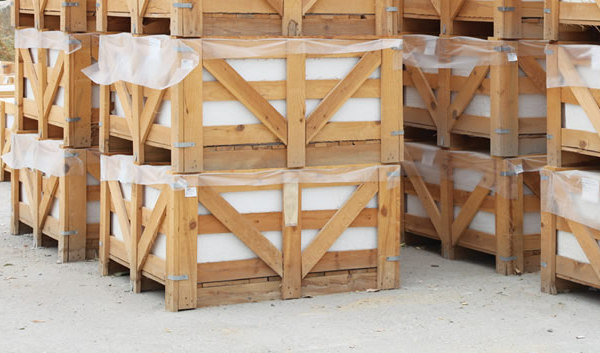All natural stone tiles including Travertine and Marble are manufactured with machinery that uses water. There are numerous processes that a large block of stone, which has been quarried out of the side of a mountain, has to go through before the end product, the tiles, are packed into wooden crates. Water is used for a number of purposes – primarily for keeping the cutting machinery cool and acting as a lubricant of sorts to aid in the manufacturing process.
Typically, a large block of stone is cut into slabs with huge parallel cutting disks or what is known as gangsaws. Then these slabs are cut into strips, then into tile shapes. All cutting equipment uses water to keep the blades cool. Whilst all of this is going on, water is absorbed into the tiles, as all natural stone is porous to a greater or lesser extent.
The finished tiles are packed into wooden crates for export across the world. Quite often, and depending upon the stone type and surface finish, the tiles will be full of water when they are packed. This water remains in the tiles throughout their journey to our warehouse and will probably still be there when they arrive with the customer.
Some stone types are more porous than others, for instance, soft limestones and pretty much all travertines are quite porous and retain a good amount of water from manufacture when they are packed. Granite and marble on the other hand tend not to retain as much, if any, and their moisture content is practically unnoticeable.
Why is all this important?
Travertine tiles in particular – especially Honed and Filled Travertine – are always wet when they are packed; the last manufacturing process, the honing, is performed with copious amounts of water. The tiles are sat flat on a machine bed, water is sprayed across them and as the honing machine finishes the surface, they absorb a lot of water. At the end of the production line they are packed into crates without having time to dry out. This is completely normal and doesn’t cause any issues other than this – the tiles when they are wet will always look two shades darker than when they are bone dry.
In the case of travertine, it gets even lighter when exposed to air over a number of months after it’s been installed. This is why on occasion we get a phone call from a customer to say “the tiles don’t look like the sample”. The truth is, they won’t look like the sample immediately as the sample is bone dry and probably a shade lighter having been exposed to air for a while. You will only get to see the true colour of travertine tiles when they are fully dry and have been installed for a couple of months.
One way to get an instant idea of what the finished color will be is to put a few up against a fan or a blow dryer for a while and see the color change as they dry out.
Installing wet stone tiles
It is good practice to take the wet tiles out of their crate and take them into the property they will be installed in prior to installation. This will allow them to “breathe” to an extent and start to dry out. Installing travertine tiles, or limestone tiles, when they are wet is not an issue. In fact, the dampness can help stop the adhesive drying out too quickly. If the tiles are really porous they can draw the water out of the adhesive before it has had time to cure properly, affecting its overall adhesion.


